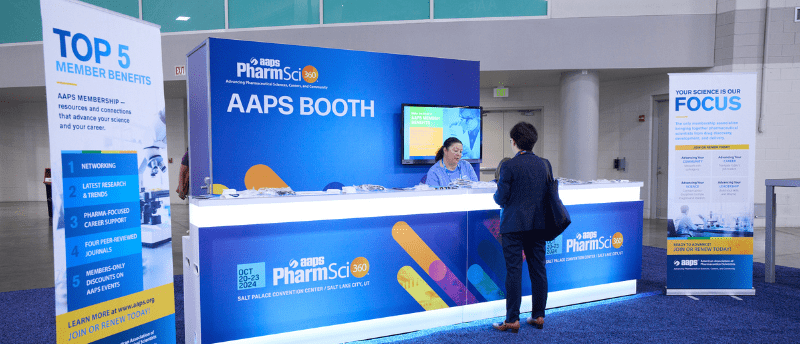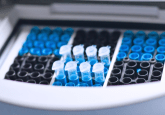AAPS PharmSci 360 2024: conference highlights from Utah

The American Association of Pharmaceutical Scientists (AAPS) PharmSci 360 2024 conference (October 21–23), Salt Palace Convention Center (UT, USA).
AAPS PharmSci 360 2024 brought together 270 exhibitors, 450 speakers and ~4,000 attendees from around the world to Salt Lake City, Utah for their annual event. Participants could enjoy a range of plenaries, rapid-fire sessions, symposia and career development workshops, as well as poster collections with the authors.
Highlights from the session
Recommended practices in enzymatic assay design, validation and long-term maintenance to support bioanalysis
Speaker: Catherine Vrentas, Booz Allen Hamilton (VA, USA)
Cathy Vrentas presented insights from a coauthored AAPS White Paper on behalf of her wider team, outlining the best practices for developing and validating enzymatic assays to support bioanalysis. Enzymatic activity plays a critical role throughout the drug lifecycle, influencing patient selection, gene therapy target engagement, PK and PD readouts, immunogenicity and surrogate endpoints. The enzymatic assay development lifecycle closely mirrors a standard bioanalytical workflow, with potentially increased importance of critical reagent management and lifecycle maintenance.
The paper explores key optimization strategies, with Cathy discussing the team’s thinking on how format (plate versus mass spectrometry), kinetic mechanisms, buffer composition, cofactors, reaction temperatures and substrate concentration can be enhanced. Cathy compared plate-based assays and mass spectrometry, highlighting the quick, inexpensive and easy scale-up of plate-based assays and the heightened sensitivity and dynamic range offered by mass spectrometry. She also covered endpoint versus kinetic reads, explaining that while endpoint reads are easy to collect and offer simple data processing, they require confirmation of the linearity of response. Conversely, kinetic reads exhibit an inherently linear response but involve more complex data analysis.
After taking us through the various elements of the paper, Cathy highlighted the key considerations for enzymatic assay lifecycle assessment, including the assessment of an assay across different analysts and buffer batches, where reagent bridging comes into play. We spoke to Cathy after her talk and she described her experience of the event:
“At this year’s PharmSci 360 conference, I was able to expand my knowledge in diverse topics related to preclinical and clinical development, including approaches for integration of AI/ML into bioanalytical workflows and biomarker strategies for emerging drug modalities. I appreciated the opportunity to present about enzymatic assay development, validation and lifecycle maintenance as a part of the Bioanalytical track, which offered me the chance to engage with other scientists who are actively developing enzymatic assays for drug development programs. As these assays involve a number of scientific challenges, continuing discussion and engagement builds the knowledge base in the field and sparks ideas for approaches to overcome technical hurdles.”
Hot Topic: FDA laboratory developed test proposed rule and biomarker testing
Speaker: Stephen Piccoli, Sun Pharma Advanced Research Center (NJ, USA)
Speaker: Patrice Hugo, IQVIA Laboratories (Quebec, Canada)
Speaker: Mark Ma, Rallybio (CT, USA)
Moderator: Lauren Stevenson, Immunologix Laboratories (FL, USA)
Stephen Piccoli opened the session by presenting information on the US FDA LDT (laboratory-developed test) Final Rule, before joining the rest of the panelists for an audience Q&A. The LDT final rule was announced on April 29 2024 and if finalized, the FDA will regulate virtually all LDTs as medical devices, imposing new regulatory requirements on those clinical laboratories offering diagnostic or exploratory biomarker tests. The rule marks the end of the broad and long-established enforcement discretion policy of LDTs under which most were not expected to meet the pre-market or post-market regulatory requirements. LDTs are now considered medical devices, and the FDA will phase out LDT enforcement discretion over a 4-year period.
LDTs are in vitro diagnostic products intended for clinical use, designed, manufactured and used within a single clinical laboratory certified under CLIA 1988. Stephen highlighted the distinct transition of LDTs from their original use to today’s usage. Originally, LDTs were manufactured in small quantities in smaller, local community labs. They tended to be manual techniques performed by laboratory personnel with specialized expertise and were generally intended for use in diagnosing rare diseases or to meet the needs of local populations. Today LDTs increasingly rely on high-tech or complex instrumentation and software to generate clinical interpretations and are often run in high volumes for large and diverse populations. They are now more often used to inform or direct critical treatment decisions, widely screen for common diseases, predict personal disease risk, diagnose serious medical conditions or used in clinical trials for medical decisions, e.g., eligibility determination, safety endpoints, etc.
The FDA has provided a 4-year, five-stage timeline for the LDT to IVD (in vitro diagnostic) transition. Stephen also highlighted work from Roche (Basel, Germany) on the predicted impact on clinical trials and patients over the next 3 years due to the LDT Final Rule using data taken from a European laboratory survey. The report estimated that 200–400 studies would be delayed in the next 3 years compared to 80–160 studies in early 2023, impacting 30,000–45,000 patients.
You can view all of the PharmSci 360 2024 posters here.
Innovating together: how diversity drives team science success
Speaker: Naiffer Romero, US Pharmacopeia (MD, USA)
Speaker: Adeola Coker, University of the Incarnate Word (TX, USA)
Speaker: Huanhuan Li, Queen’s University Belfast (UK)
Speaker: Tapan Das, Spyre Therapeutics (MA, USA)
Moderator: Allison Radwick, U.S. Pharmacopeia
In this open Panel discussion, we got to hear each panelist’s experiences with maximizing diversity within scientific teams and the methods they’ve found effective to achieve this. The importance of multidimensional diversity was emphasized, i.e., not just considering race and gender, but also socio-economic background, sexual orientation, etc. Diversity can also be found in the form of skills; the panelists concurred that the best papers and pharmaceutical products often come from diverse, well-rounded teams that possess a 360-degree view of tackling a problem. Tapan recalled that a previously advertised job description was used to recruit for a new position during a hiring period at his lab. He explains that by simply tweaking existing role descriptions, you can ensure you’re hiring a person with a different experience and not just a ‘clone’ of a current team member. Supervisors and team leaders tend to hold the responsibility of hiring new personnel, but Tapan emphasized that it is important that we voice our own opinions regarding the skills and background needed for a new role.
Adeola recalled her experiences from academic hiring, recalling the challenges she’d faced when trying to maximize diversity in her team. She found that first-generation students who may lack family members who are familiar with the education system for medicine, in particular, needed more support in their learning and when it came to applying for roles. Adeola noted that it is important to personalize teaching and mentoring by understanding each person’s perspective and by creating a space where everyone feels welcome and doesn’t stand out. She emphasized that you have to be intentional with hiring; go to places that have the types of people you’re missing – don’t expect them to always come to you. Once a team becomes diverse, it becomes easier for people to approach it and see themselves working there. Finally, the group found that team shadowing – swapping personnel between teams for short periods – created diversity internally and provided new perspectives to the new and old teams.
Another key point made during this discussion was that of patient populations. In order to create pharmaceutical products that will benefit everyone, we must ensure that our testing populations are diverse and match our patient populations.
You can take a look at our previous conference reports here.





